Rebecca’s Recipe of the Week: Meera Sodha’s Coconut-Tamarind Potatoes
This is a flavoursome dish that plays to the potato’s strength as a vehicle for strong flavours. Here your Canalside spuds combine with the richness of coconut milk and the sharp, sour tang of tamarind to deliver a punchy, satisfying dose of carbohydrates. Cashews and crispy onions contribute additional crunch. A sprinkling of green coriander over the top looks lovely and adds an additional freshness.
It is particularly good combined with the south Indian beetroot and coconut dip whose recipe I will provide in my next instalment.
Potatoes with Tamarind, Coconut and Cashews
Serves 4-6 as part of a larger spread.
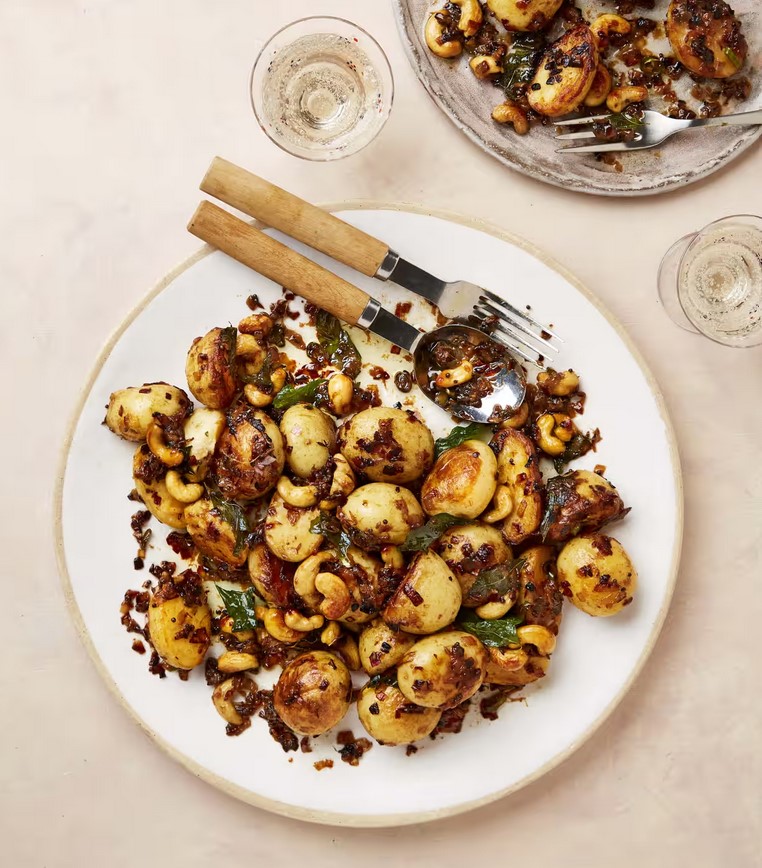
Ingredients
1kg potatoes
3 tablespoons coconut oil
1 teaspoon black mustard seeds
1 teaspoon cumin seeds
10 fresh or frozen curry leaves
300g shallots, peeled and sliced fine—or you can use onion, really
3 garlic cloves, peeled and crushed
2cm piece of fresh ginger, peeled and grated
2 green chiles, finely chopped (take out the seeds if you prefer, and also adjust the quantity to taste)
100g cashew nuts
1 teaspoon salt
2 teaspoons tamarind paste
200ml coconut milk
a handful of coriander leaves, chopped, to garnish (optional)
Preparation
Put the potatoes in a pan and cover with cold water. Bring to a boil over low heat and cook gently until they are tender. How long this takes will depend on the size of the potatoes, so this process can last between 20 and 45 minutes. When the potatoes are tender drain them and set them aside. Once they are cook enough to handle cut them into bite-sized pieces. You can do this well in advance if you wish.
Combine the mustard seeds, cumin seeds and curry leaves in a little dish. Combine the garlic, ginger, chiles and cashews in another dish. You’re now all set to add each tranche of ingredients without having to fuss around with lots of separate items.
Put the oil in a large frying pan over medium heat. When it is hot add the mustard, cumin and curry leaves. Once the seeds start to sizzle add the shallots and cook, stirring, for about eight minutes, or until the shallots starts to brown.
Add the garlic, ginger, chiles and cashews to the pan. Cook, stirring regularly, for another two minutes. Now add the drained potatoes in a single layer and sprinkle with salt. Turn the heat to high and fry for about five minutes, stirring once, until the potatoes are turning an appetising brown. Don’t stir them constantly, or they won’t brown.
Finally, add the tamarind paste and the coconut milk. Leave to cook, stirring regularly, until the coconut milk has mostly evaporated and turned into a sticky glaze. Serve hot, cold or at room temperature. It looks nice garnished with some chopped fresh coriander.
Recipe adapted from Meera Sodha, The Guardian, 12 June 2021.
Rebecca’s Recipe of the Week: A Surprising Salad Dressing
This very delicious recipe is from the Moosewood, a pioneering vegetarian restaurant in Ithaca, New York State, where I (mostly) grew up. The carrot makes the dressing a beautiful bright orange. The sesame oil, ginger and soya sauce balance the carrot’s sweetness (although you can add additional sugar if you like). The Moosewood Collective note that if you use this dressing on iceberg lettuce you will make ‘that Japanese restaurant bento box salad’. They also recommend it as a topping on grilled fish, or as a dip for green beans or sugar-snap peas.
If you don’t have a set of cup measures, you can measure the carrots and onions in measuring jug. A US cup is 8 fluid ounces, so ½ a cup of grated carrots is 4 fluid ounces, and ¼ cup of chopped onion is 2 fluid ounces.
Japanese Carrot Dressing
Yields about 10 ounces.
Ingredients
½ cup carrots (about 2 medium-sized carrots).
¼ cup onion or shallot, chopped
8 ounces vegetable oil
3 tablespoons rice wine vinegar
1.5 tablespoons grated fresh ginger
1 tablespoon soya sauce
1 teaspoon sesame oil
2 tablespoons water
¼ teaspoon salt
1 teaspoon brown sugar (optional)
black pepper
Preparation
Combine all the ingredients except the sugar and pepper in a blender and whizz. Start on low and the gradually increase the speed until the purée is smooth. Taste the dressing; add the brown sugar if you’d like this a little sweeter, and also add pepper and more salt, to taste.
Recipe adapted from Moosewood Collective, Moosewood Restaurant Favorites: The 250 Most Requested Naturally Delicious Recipes from One of America’s Best-loved Restaurants (2013).
Rob’s Recipe of the Week: Quick tasty salad side
This is a bit of a summer favourite for getting a quick hit of refreshing and flavorful nutrition alongside the rest of lunch. It’s easily adaptable to personal taste by adding things like feta cheese, so make it your own!
Ingredients
Cucumber
Red onion or shallots
Tomatoes
Black olives
Lemon juice
Olive oil
Salt
Method
Finely dice equal parts cucumber onion and tomato. Mix and add some diced olives, a splash of lemon juice a dash of salt and a good helping of olive oil.
Rebecca’s Recipe of the Week: Sicilian Pasta
This is a bit of a production, but the flavours you will create are remarkable. The dish tastes of the sea, of warm evenings outdoors, of blue skies. Make it now.
Pasta with Cauliflower, Currants, Pine Nuts and Saffron Onions
Serves 4
Ingredients
80g currants (or raisins)
230ml white wine
60ml olive oil, plus 2 tablespoons more
2 medium onions, peeled and diced
salt
1 teaspoon saffron threads
100g coarse breadcrumbs
700g cauliflower, cut into very small florets
3 garlic cloves peeled and chopped
8 anchovy fillets, rinsed and chopped
1 teaspoon red pepper flakes
handful of parsley, large stalks removed and coarsely chopped
12 sprigs of marjoram, coarsely chopped
450g short pasta shapes
Preparation
First plump the currants: put the currants and wine in a small saucepan over low heat. Bring to the boil and—as soon as it reaches the boil—remove from the heat and set aside for at least 30 minutes. The currants will absorb the wine.
Now prepare the saffron water: put the saffron and 60ml of water into a small bowl. Heat in the microwave for 30 seconds or so, or until the water boils. The moment the water boils remove and set aside for at least 5 minutes. (Of course you can do this on the stove.)
Now make the saffron onions: put 60ml of oil into a frying pan over low heat. When hot add the onions and a pinch of salt and cook for about 8 minutes, or until the onions are beginning to soften, but still remain golden.
Add the saffron water and continue to cook, stirring occasionally, for 10-15 more minutes, or until the onions are very soften and have turned a beautiful saffron colour. Don’t let them burn.
Toast the breadcrumbs: toast the breadcrumbs in a dry frying pan for 5-8 minutes, or until they are a golden colour. Keep an eye on them so they don’t burn. You can add some oil if you prefer. You can also make them in a 150C oven—they’ll take about 20 minutes.
Meanwhile, cook the cauliflower: put the remaining 2 tablespoons of olive oil and 60ml of water into a separate pan. Bring to the boil and then add the cauliflower. Cover and cook over medium-low heat for about 15 minutes, or until the cauliflower is extremely soft. Check every now and then to make sure there is enough water—don’t let this boil dry—and add more if necessary.
Once the cauliflower is soft, make a well in the middle of the cauliflower and add the garlic, anchovies and pepper flakes. Sizzle over low heat until the anchovies have broken down and merged with the rest of the ingredients in the pan.
Now add to the cauliflower the saffron onions, currants (and any remaining wine), parsley and marjoram.
Your sauce is now ready.
Cook the pasta according to the package directions whenever you are ready to eat. Reserve about 60ml of the cooking water when you drain it. You will add this to the finished dish.
To serve, combine the pasta and sauce and toss well. Add the reserved cooking water and heat over a low flame for a minute or two until it’s hot and well blended. Top with the breadcrumbs and serve with a glass of white wine, imagining yourself on a balcony in Sicily.
Recipe adapted from Christopher Boswell, Pasta: Recipes from the Kitchen of the American Academy in Rome (2013).
Rebecca’s Recipe of the Week: Parsnips, Squash, Capers, Parsley
Everyone knows roasted vegetables are good. Adding a punchy caper and parsley vinaigrette makes them even better. You can use different vegetables (potatoes, say), and you can also vary the vinaigrette by adding harissa paste, or using basil or mint instead of parsley.
Served with rice or another grain to soak up the vinaigrette, this makes a good weekday dinner. You can add some salted yoghurt if you want additional creaminess (and protein).
Roasted Parsnips and Squash with Caper Vinaigrette
Serves 3-4
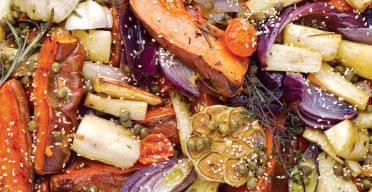
Ingredients
For the roast veg
700g parsnips, peeled
700g squash or pumpkin
120ml olive oil
4 medium red onions (optional)
4 sprigs of thyme
2 sprigs of rosemary
1 teaspoon salt
Several grinds of black pepper
1 whole head of garlic
10-20 small tomatoes, cut in half
For the dressing
1 large lemon
2 tablespoons olive oil
3 tablespoons capers, roughly chopped if they are large
1.5 teaspoons honey or maple syrup
½ teaspoon Dijon mustard
big handful of parsley, chopped fine
½ teaspoon salt
Several grinds of black pepper
Preparation
Prepare the roast veg:
Preheat oven to 190C.
Cut each parsnip into batons about 5cm long and 1.5 wide—but if they are small it is fine to leave them whole. They will look amusing in the finished dish.
Using your hand, scoop the seeds out the squash. (You can use these to make a nice nibble: https://www.101cookbooks.com/toasted-pumpkin-seeds/.) Peel the squash and cut it into chunks roughly the same size as your parsnips.
Peel the onions (if using) and cut each into 6 wedges.
Cut the head of garlic in half horizontally. Don’t break it into individual cloves or try to peel it! Just cut the whole thing into two pieces, horizontally.
Place the parsnips, squash, onions and garlic into a roasting tin and add 120ml olive oil, the thyme and rosemary, 1teaspoon salt, and some pepper. Mix well and spread it out in the pan so the vegetables are not all heaped on top of themselves. Place in the oven and roast for about 20 minutes, or until the vegetables look golden and are pretty tender.
After 20 minutes add the tomatoes, and roast for another 10 minutes or so, until the vegetables are completely tender when prodded with a fork and the tomatoes have softened.
While the vegetables are roasting prepare the vinaigrette: zest the lemon and then cut it in half so you can juice it. Combine the lemon juice (about 2 tablespoons) and zest with the other ingredients in a small bowl. Whisk to combine.
Finish the dish: Once the vegetables are done, remove them from the oven and pour the vinaigrette over the hot vegetables. Toss to combine and serve with rice or some other grain.
Recipe adapted from Yotam Ottolenghi, Plenty (2010).
Rob’s Recipe of the Week: Beets and Chard from the Share
As always I continue to try to find new ways to enjoy roasted beetroot as it takes us through the winter and this week I think I’ve found a good one. Either a fun lunch or a dinner padded out with some nice bread, you choose!
Warm lentils with roasted beets, wilted chard & goat cheese
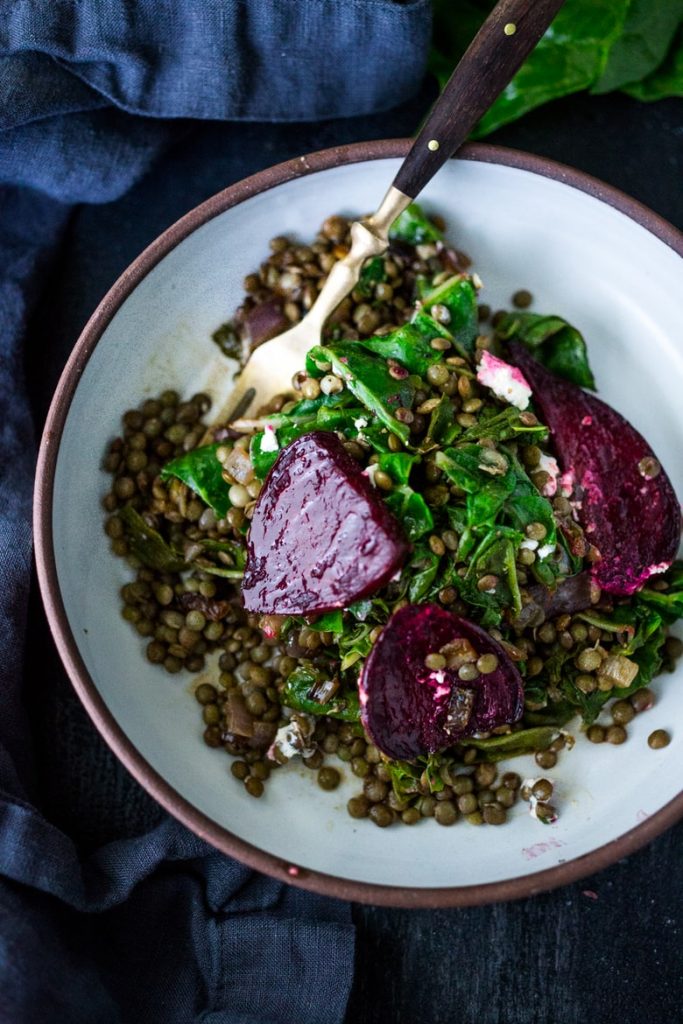
Ingredients
3–4 beetroot ( enough for 2 people)
2 cups cooked lentils
2 tablespoons olive oil
½ a red onion- diced
3 garlic cloves- rough chopped
4 cups (packed) swiss chard or rainbow chard- chopped (or sub beet greens, spinach)
salt and pepper to taste
1 tablespoon balsamic vinegar, more to taste
¼ cup goat cheese crumbles
2–3 tablespoons fresh basil, or parsley.
Instructions
Preheat oven to 220C. Scrub and trim beetrot and cut into ½ inch slices or wedges. Drizzle with olive oil and roast until tender, about 25- 30 minutes.
If cooking lentils, place ¾ cup dried lentils in a small pot and cover with 3 inches of water and a pinch salt. Bring to a boil, cover and turn heat down to a simmer, cook about 25-30 minutes or until tender but still hold their shape. Drain.
In a large frying pan, heat 2 tablespoons oil over medium high heat. Add diced onion and saute 3-4 minutes. Turn heat down to medium, add garlic and cook 2 more minutes, until golden and fragrant.
Lower heat to medium low. Add chard and gently wilt, just slightly, about 2-3 more minutes. Season with salt and pepper.
Add 2 cups cooked lentils to the frying pan, gently folding them in and warming. Season again with salt and pepper.
Add beetrot and splash with 1 tablespoon balsamic vinegar. Let vinegar cook down for just a couple of minutes so it’s not so acidic. Taste, add more vinegar if you like, cooking it down. Sprinkle with goat cheese and herbs. Taste again, if it tastes bland it most likely needs salt. Serve immediately.
From https://www.feastingathome.com/warm-lentils-wilted-chard-roasted-beets-and-goat-cheese/
Rebecca’s Recipe of the Week: Spicy Potato-Parsnip Soup with Preserved Lemon
Here is a good soup for a blustery spring day. The warming spices—cumin, coriander, paprika—give this a North African flavour, as does the preserved lemon. You can make this with any ratio of potatoes or parsnips that you prefer, including all potato or all parsnip. We enjoyed this with a glass of very robust Bulgarian merlot but other drinks are available, as they say.
Note that this involves only one pan, and so results in minimal washing-up.
Spicy Potato-Parsnip Soup with Preserved Lemon
Serves 2
Ingredients
For the Soup
2 tablespoons rapeseed or olive oil
1 onion, roughly chopped
2 garlic cloves, roughly chopped
½ dried Canalside chile, deseeded if you don’t want it too hot and chopped, or 1 medium-hot dried chile, treated similarly
1 teaspoon ground cumin
1 teaspoon ground coriander
½ teaspoon sweet smoked paprika (use a Spanish brand)
¼ cup preserved lemon, chopped fairly coarsely
500g peeled potatoes and parsnips, in any ratio (you can use all potatoes or all parsnips, too)
About 750ml stock (I think you could also use water, to be honest)
1 teaspoon salt
To decorate the Soup
4 tablespoons yoghurt
a little more smoked paprika
a little extra preserved lemon, coarsely chopped
Preparation
Heat the oil in a large saucepan over medium heat. Add the onion, garlic and chile, reduce the heat to low, and sauté gently for 10-15 minutes, or until the onion is soft but not brown. Stir in the cumin, coriander and paprika and cook for a minute or two more, until everything smells fragrant.
Meanwhile, cut the peeled vegetables into chunks of about 2cm.
When the spices in the pan are fragrant add the vegetables and the preserved lemon and pour in the stock (or water) and the salt. Bring to a simmer and cook for 30-40 minutes, or until the vegetables are very tender indeed.
Using a potato masher, mash the vegetables to give the soup a coarse texture. Hugh F-W suggests passing the whole thing through a sieve to create a smooth puree, but this seems both a lot of work and a dubious outcome as in my view a more rustic texture suits this soup far better. But it’s up to you. Add a bit of water if it still seems a bit thick to you, and check to see if it would benefit from a bit more salt.
To serve, dish your soup into bowls and garnish each with several spoonfuls of yoghurt, a sprinkling of paprika, and some golden cubes of preserved lemon.
Recipe adapted from Hugh Fearnley-Whittingstall, River Cottage Veg Every Day! (2011).
Rebecca’s Recipe of the Week: Hasselback Celeriac with Miso and Red Onion
Meera Sodha says she created this recipe largely because she liked the sound of ‘hasselback celeriac’. Name aside, this is very good. Serve the rich, miso-roasted celeriac and Turkish salad inside a flatbread, topped with a drizzle of tahini sauce and you will have yourself a sticky, messy treat. The recipe has several different components but is actually very straightforward.
Incidentally, Hasselback is the name of a restaurant in Stockholm. The better-known Hasselback potatoes were supposedly invented there in the 1950s.
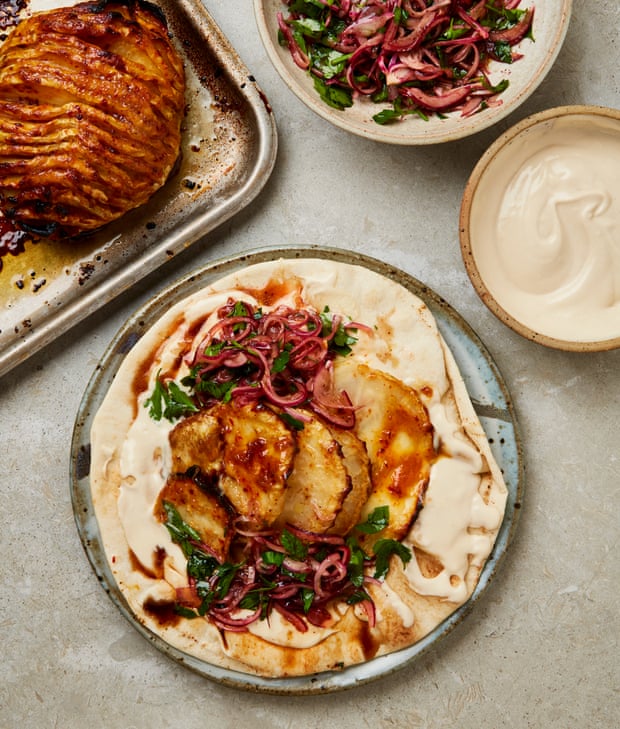
Hasselback Celeriac with Miso and Red Onion
Serves 3
Ingredients
For the celeriac
1 large or 2 small celeriacs (about 1-1.2kg total)
2 tablespoons olive oil
pinch of salt
For the miso glaze
60g white miso
½ tablespoon Turkish pepper
2½ tablespoons honey or brown rice syrup
1½ tablespoons lemon juice
For the tahini sauce
100g tahini
5 tablespoons water
1 tablespoon lemon juice
½ teaspoon salt
For the salad
1 large red onion, peeled, halved and sliced into thin half-moons
1 tablespoon pomegranate molasses
1 tablespoon lemon juice
1 teaspoon sumac
3 tablespoons olive oil
¼ teaspoon salt
1 large handful parsley, coarsely chopped
To Serve
6 flatbreads (look here for an excellent recipe)
Preparation
Heat the oven to 200C (180C fan).
Chop off the base of the celeriac, and peel off the skin using a peeler or a sharp knife. If it is large, cut it in half and lay it flat on its cut side. Using your sharp knife, cut slices at 5mm intervals that go nearly but not all the way through, so that the slices are still joined at the base, like the pages join the spine of a book. The illustration shows one way to ensure that you don’t accidentally cut all the way through: place a wooden spoon handle or chopstick on either side of the celeriac, so that when you cut, they prevent the knife from slicing all the way to the work-top.
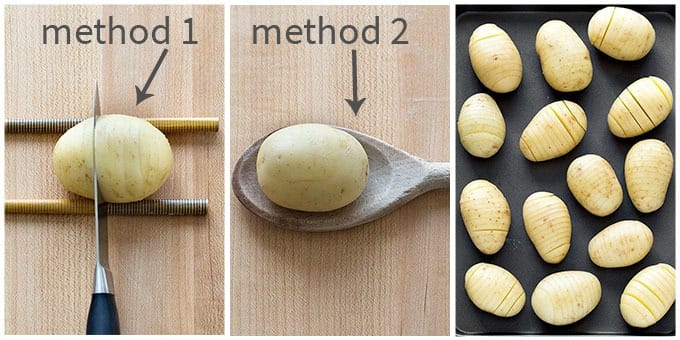
Now place the celeriacs on a baking sheet and drizzle with 2 tablespoons of oil and a pinch of salt. Place in the oven and roast for 70-90 minutes. Check partway through and drizzle with a little more oil if necessary. When they golden brown, they are ready for the glaze.
While the celeriacs roast, prepare the other components of the meal.
For the miso glaze: mix all the ingredients together in a small bowl.
For the tahini sauce: whisk all the ingredients together and put in a serving bowl.
For the salad: combine all the ingredients except the parsley in a serving bow. Mix together using your hands, and scrunch up the onions a little to soften them. Then add the parsley and set aside so the flavours can blend while the celeriac roasts.
Once the celeriac is golden and tender, brush with the miso glaze. Try to get some of the glaze between the slits. Bake for another 8-15 minutes, or until the celeriac is sticky and golden brown.
To serve, take the celeriac, salad, tahini sauce and bread to the table. Assemble your own combination of flatbread layered with celeriac and pomegranate-onion salad, topped with a generous serving of tahini sauce.
Recipe adapted from Meera Sodha, The Guardian, 13 Feb. 2021
Rebecca’s Recipe of the Week: To the Immortal Memory
This past Monday was Burns Night. A proper Burns Night supper should include, alongside haggis and a good deal of whisky, a convivial toast to the immortal memory of Robert Burns. This year, as we long for conviviality, and remember the shades of a great many people, it seems appropriate to offer a traditional Scottish dish, worthy of a private, 2021 version of Burns Night, or just a meditative mid-week supper.
The dish I’ve chosen is Cullen Skink, a sort of Scottish version of vichyssoise. It consists of a creamy leek and potato soup augmented with rich and salty smoked haddock. It’s best eaten with a piece of good bread. This recipe (and some bread) will satisfy four convivial or meditative diners.
Cullen Skink takes its name from the village of Cullen, in north-eastern Scotland, and the word ‘skink’, which means ‘soup’. (Skink, if you’re interested, probably comes from the Middle High German Schinke, or ham.) Neither the Oxford English Dictionary nor I have succeeded in tracing the dish back earlier than than about 1910, so it’s probably not the most ancient of Scottish recipes, but it’s very good nonetheless.
Cullen Skink
Serves 4
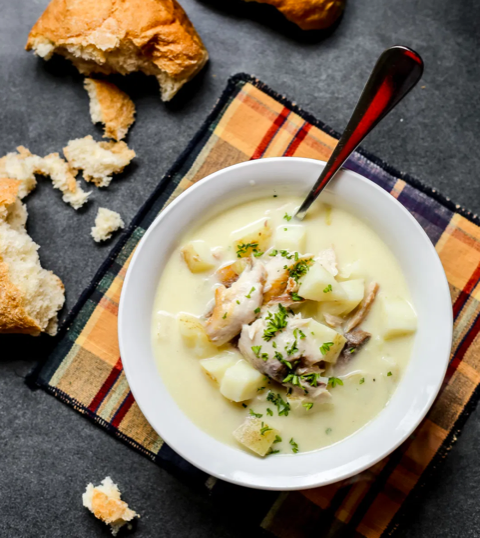
Ingredients
300g onions
500g leeks
60g butter
500g potatoes
4 bay leaves
1 lemon, juiced
Freshly-ground black pepper
400g natural (undyed) smoked haddock, cut into large chunks
150ml single cream
2l boiling water
Fresh chives, to garnish
Preparation
Peel the onions and dice them into 1cm chunks.
Top and tail the leeks. Cut the leeks into 1cm chunks and then rinse them in a colander to remove any dirt.
Heat the butter in a large, heavy-bottomed saucepan. When it is melted add the onions and leeks and cook over very low heat for at least 20 minutes, or until the vegetables look tender and soft, but not browned. Keep an eye on it so that they don’t stick or burn. It is fine to cook them for longer.
Meanwhile, prepare the potatoes. I’d favour leaving them unpeeled but if this seems wrong to you feel free to peel them. In any case, chop them into 2cm chunks and set aside.
Once the onions and leeks are soft and very translucent, add the bay leaves, lemon juice and pepper to the pan. Stir and then add the potatoes. Cook for 10 more minutes, so that the potatoes start to release their starch, which will make for a nice, thick soup.
Add the water to the pan, so that the vegetables are completely submerged. Bring to a simmer and cook for 15-25 minutes, or until the potatoes are tender. Add more water along the way if necessary to ensure that the vegetables remain under water.
Once the potatoes are tender, add the haddock and cook over low heat for another 5 minutes or so. Pour in the cream and cook over a very low heat until the soup is heated through. If you’d like it thicker, simmer it for a further 10 minutes. Taste to check the seasonings and add more salt (the fish will already have brought considerable salt to the dish), pepper or lemon if you like.
Serve, garnishing the bowls with chopped chives and a further grind of black pepper.
Recipe adapted from Tesco Magazine, Jan. 2021.
Rebecca’s Recipe of the Week: Roast Parsnips, Lentils, Cheese
Here we have a warm, sustaining main-course salad made bright with greens and the bite of mustard. It’s a good use of that parsnip that’s still in your fridge. You can make a meal of this, along with some good bread and a glass of red wine.
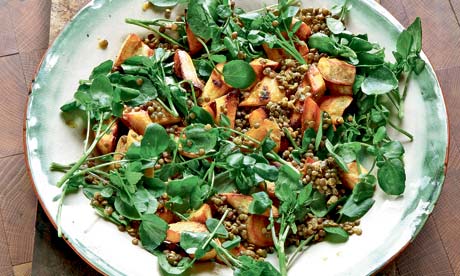
Roast Parsnip, Watercress and Lentil Salad
Serves 3
Ingredients
Salad
5 medium parsnips
2 tablespoons oil
salt and pepper
125g Puy or green lentils
2 bay leaves
1 medium onion, unpeeled
several parsley stems (optional)
several big handfuls of watercress or rocket
any hard cheese, to shave over the top
Salad dressing
1 clove garlic
½ teaspoon salt
1 teaspoon English mustard
2 teaspoons runny honey
1 tablespoon lemon juice
4 tablespoons rapeseed oil
Preparation
Preheat your oven to 190C.
Peel the parsnips and cut them into chunky batons. Toss them with the oil and a sprinkling of salt and pepper. Tip them onto a baking tray and roast for 30-40 minutes, or until they are tender and a bit golden. The time will depend on how large they are. You can poke them with a fork to see if they are soft inside. Remove from the oven and leave them to one side.
Meanwhile, prepare the lentils: cover them with boiling water and bring back to a boil. Boil for one minute, and then drain.
Return the drained lentils to the pan and add just enough water to cover them. Add the bay leaves, onion and parsley stalks (if you have any to hand). Bring to the boil, reduce to a simmer, and simmer for about 30 minutes, or until al dente. Drain and remove the bay leaves and parsley. It’s up to you either to remove the onion or to leave it in the finished salad.
While the lentils cook and the parsnips roast prepare the salad dressing. Mash the garlic with the salt in a mortar and pestle to make a smooth paste. Whisk in the other ingredients.
When the parsnips and lentils are finished, toss them, still warm, with the dressing and add the watercress or rocket. Pile onto a serving platter and shave some hard cheese over the top before serving.
Recipe adapted from Hugh Fearnley-Whittingstall, River Cottage Veg Every Day! (2011) – online at rivercottage.net